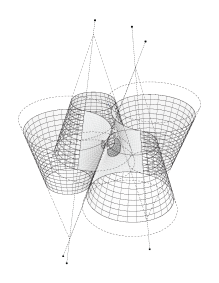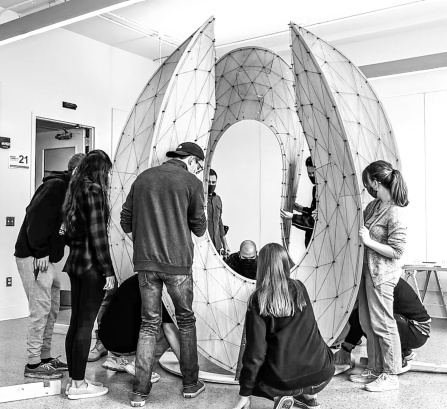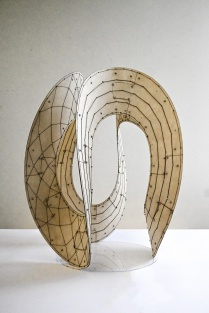Figure to Fiber
Examples of paper forms created within surface disclination studies.
Published December 9, 2022
The Spring 2021 Situated Technologies research studio returned to the topics of geometry and topology through surface disclinations, introduced by Assistant Professor Nicholas Bruscia in 2019 as both a developing area of research and a pedagogical exercise.
Figure to Fiber
The studio looked to explore contemporary notions of material customization that are guided by geometric principles. Topics explored within this studio were three-fold. First, the scalability of surface disclinations and how to enhance their stability with a synthetic fibrous layer. Secondly, an exploration of their aggregation into larger structures via periodic tilings. And thirdly, how to harness their "snap-through buckling" to increase bending stiffness within thin surfaces.
Some natural materials and formations are shaped by disclinations, or “defects” in their topological composition, that force curvature into initially flat or planar elements. Originating in crystallography, the basic principle can be applied to materials at larger scales. For example, the intuitive materialization of these formal characteristics are observed in traditional Japanese kagome basket weaving techniques. Students looked to small studies of paper models to experiment with the ways in which a basic geometric figure, or a flat square, circle and triangle, can transform through the overlapping of material to create positive or negative curvature. By studying these paper models, students observed how material can self-react and transform into complex and self-stabilizing structures that have inherent mathematical rationality.
Geometric construction meshes / bending simulation.
Paper models of counter-active bending / forcing two modules to balance between stable states.
Students worked with paper form-finding models and physics-based digital simulation to discover ways to increase the bending stiffness within a thin surface. This flexure and bending resulted in the understanding of material behaviors. With the observation of material behaviors, students were able to begin manipulating forms through newly introduced curvatures to control a desired outcome. This change in curvature was often paired with tiling and specific arrangements of tilling that could transform a planar surface into a collective and distributed experience, rather than a centralized object.
With the digital representations and material understandings, students moved into large-scale physical mockups of their designs. Working with two layers of 3mm plywood with staggered seams allowed the projects to scale up well beyond the dimensional limitations of standard sheet materials. The synthetic fibrous skin and natural wood grain of the material could be used to help accommodate areas that had tighter bending radii or to increase surface stiffness in other areas. These internal stresses within the mockups are distributed evenly throughout the structure once it was completed, further stabilizing the form.
Within the final fabrication phase, students also looked to examples of joining seams to help stabilize their plywood mockups. Research was done on the benefits of each binding and joining technique to choose the most beneficial option for each structure and its geometry. Students explored incorporating carbon fiber reinforcement and designed seam details to strategically allow for disassembly and transport. The student work exhibits the potential of topological bending at a large scale, opening up possibilities for further educational research that combines material behavior and geometry toward new fabrication techniques. While stereotomic projection is associated with shaping mass, surface disclinations may be associated with shaping thinness, turning our attention away from the monolithic and toward the monocoque.
Plywood mockup within Crosby Hall for Atilier week.
Aggregation test model.
Students: Josh Barzideh, Tyler Beerse, Tom Cleary, Camilo Copete, Bhalendu Gautam, Sam Goembel, Marissa Hayden, Ollie He, Nick Hills, Jamie Jones, Lovepreet Kaur, Ben Starr
Faculty: Nicholas Bruscia
Term: Spring 2021
Course: ARC 607, Situated Technologies
Program: M.Arch





